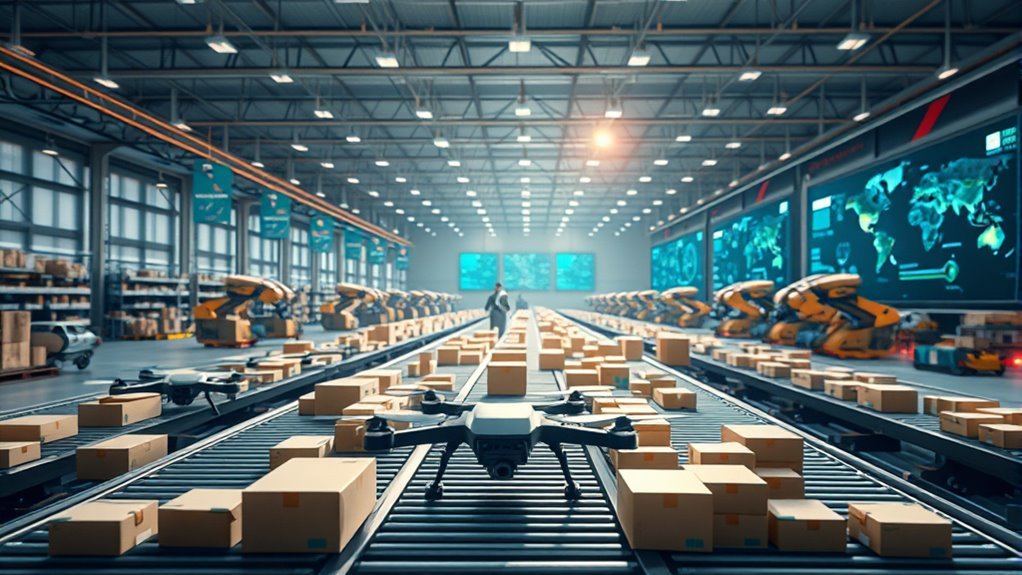Using AI for supply chain optimization in logistics helps you drive efficiency and cut costs by automating routine tasks and improving real-time decision-making. You can leverage predictive analytics to forecast demand accurately, optimize inventory, and enhance transportation routes using machine learning and IoT data. This reduces delays and waste, while improving customer satisfaction through timely deliveries. Exploring key technologies and strategies will reveal how to overcome common implementation challenges and fully access AI’s potential in your logistics operations.
Benefits of AI Integration in Supply Chain Management

When you integrate AI into supply chain management, you gain the ability to analyze vast amounts of data quickly and accurately, enabling smarter decision-making at every stage. This lets you identify inefficiencies and bottlenecks, driving significant cost reduction by optimizing inventory levels and minimizing waste. With AI-powered process automation, routine tasks like order processing and demand forecasting become seamless, freeing you to focus on strategic priorities. You’ll reduce human error and speed up operations, creating a more agile supply chain that adapts swiftly to market changes. By leveraging AI, you’re not just cutting expenses—you’re gaining operational freedom, allowing you to innovate and respond proactively rather than reactively. This transformation empowers you to maintain competitive advantage while streamlining your entire supply chain ecosystem. Additionally, integrating AI with cloud computing facilitates real-time data analytics, enhancing operational efficiency and decision-making capabilities.
Key AI Technologies Transforming Logistics

Although logistics involves complex, interdependent processes, key AI technologies have emerged that can streamline operations and boost efficiency considerably. Machine learning enhances route optimization by analyzing patterns, while robotic process automation (RPA) accelerates repetitive tasks like inventory management. Together, these technologies free you from manual bottlenecks, allowing smarter allocation of resources.
| Technology | Function | Impact |
|---|---|---|
| Machine Learning | Data-driven decision making | Optimizes routes and deliveries |
| Robotic Process Automation | Automates repetitive tasks | Increases operational speed |
| Computer Vision | Real-time monitoring | Improves asset tracking |
| Natural Language Processing | Enhances communication | Streamlines customer service |
| IoT Integration | Connects devices and sensors | Enables proactive maintenance |
Clear communication and precise prompts are essential for maximizing AI-driven insights in logistics report generation.
Predictive Analytics for Demand Forecasting

Building on AI technologies like machine learning and IoT integration, predictive analytics plays an essential role in fine-tuning demand forecasting. You’ll gain a strategic edge by analyzing historical data and real-time inputs to identify evolving demand patterns. This lets you anticipate shifts before they impact your supply chain, improving forecasting accuracy considerably. With more precise forecasts, you can reduce waste, avoid stockouts, and optimize resource allocation. The freedom to act proactively rather than reactively empowers you to meet customer needs efficiently while controlling costs. By continuously refining models with fresh data, predictive analytics adapts to market changes, keeping your decisions sharp and reliable. Embracing this approach means you’re not just reacting to demand—you’re outpacing it. Leveraging cloud scalability allows supply chain systems to dynamically adjust resources, enhancing the responsiveness and efficiency of predictive analytics in logistics.
AI-Driven Inventory and Warehouse Management
Since efficient inventory and warehouse management directly impacts your supply chain’s responsiveness and cost-efficiency, leveraging AI-driven solutions is essential. You can implement automated replenishment systems that monitor stock levels in real time, triggering orders only when necessary, reducing both overstock and stockouts. Smart shelving technologies, equipped with sensors and AI analytics, help you track item locations and conditions precisely, minimizing errors and improving retrieval speed. This approach frees you from manual inventory checks, allowing more strategic allocation of resources and space. By integrating these AI tools, you gain greater visibility and control, which translates to faster decision-making and reduced operational costs. Ultimately, embracing AI in inventory and warehouse management gives you the freedom to scale efficiently without sacrificing accuracy or agility. Additionally, adopting Infrastructure as Code practices like AWS CloudFormation enables streamlined and consistent deployment of the AI systems supporting these optimizations.
Enhancing Transportation and Delivery With AI
When you integrate AI into transportation and delivery, you gain the ability to optimize routes, predict delays, and manage fleets more efficiently. AI-powered route optimization analyzes traffic patterns, weather, and delivery windows in real time, helping you avoid bottlenecks and reduce fuel consumption. Real time tracking provides visibility over shipments, enabling proactive responses to disruptions and ensuring timely deliveries. This transparency gives you control and flexibility, letting you adjust plans dynamically to meet customer expectations without unnecessary downtime. Strategically leveraging these AI tools lets you streamline operations, cut costs, and maintain a competitive edge. Embracing AI in your transportation and delivery processes grants the freedom to run a responsive, agile supply chain that adapts swiftly to changing conditions while maximizing efficiency. Companies like Maersk illustrate how integrating cloud-native technologies with AI enhances real-time monitoring and supply chain optimization.
Challenges and Considerations in Implementing AI Solutions
You’ll need to address data quality issues upfront, since inaccurate or incomplete information can derail AI performance. Integrating AI with your existing legacy systems also requires a strategic approach to avoid disruptions and guarantee smooth workflows. Planning for these challenges early will help you maximize the benefits of AI in your supply chain. Additionally, implementing continuous monitoring can help detect and resolve data anomalies that might affect AI accuracy.
Data Quality Issues
Although AI promises significant improvements in supply chain efficiency, its success heavily depends on the quality of the data it processes. You’ll need to prioritize data cleansing and rigorous data validation to guarantee accurate, reliable inputs. Poor data quality leads to flawed AI insights, undermining decision-making and operational freedom.
Key data quality issues to watch for include:
- Incomplete or missing data points
- Inconsistent data formats across sources
- Duplicate or outdated records
- Errors from manual data entry
- Lack of standardized measurement units
Integration With Legacy Systems
Since many supply chains rely on legacy systems built years ago, integrating AI solutions requires careful planning to avoid disruptions. You’ll need to assess legacy system compatibility thoroughly to guarantee your AI tools can communicate effectively without causing downtime. Prioritize establishing seamless data transfer protocols that bridge old and new technologies, preventing data silos and inconsistencies. Consider middleware or APIs as strategic connectors, enabling your AI to pull real-time insights without overhauling your entire infrastructure. Keep in mind, phased implementation reduces risks and gives your team room to adapt. By focusing on compatibility and seamless integration, you’ll maintain operational freedom while unlocking AI’s full potential to optimize logistics efficiently and reliably.



